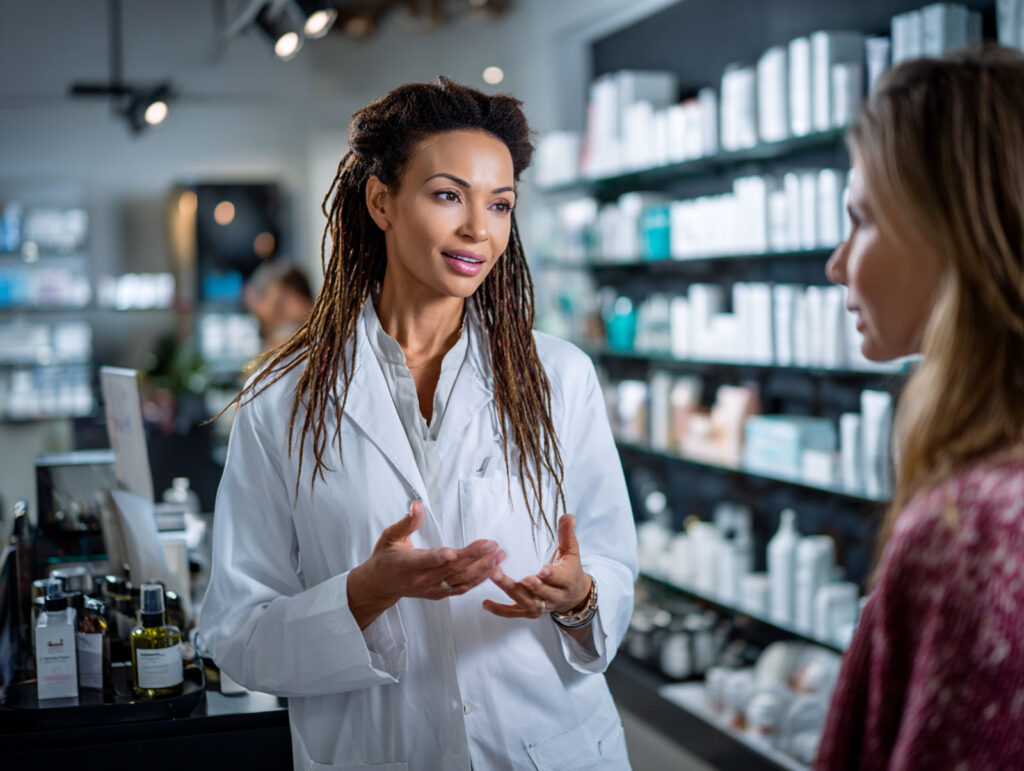Estheticians, Professional Skincare, Salon Biz
Peeking Behind the Medical-Grade Skincare Label
I still remember stepping into a dermatology clinic for a routine mole check and leaving with a shiny white bag that cost more than my monthly grocery bill. The bag carried the words “medical grade” in tasteful silver lettering, and the receptionist assured me I was taking home science in a jar. A 2025 Provoke Insights survey found that 87 percent of skincare users say dermatological credibility is important, yet only one in five actually lets a dermatologist’s advice guide the final purchase decision (Summer 2025 Skincare.pdf). That gap between perceived authority and real-world action is where the mystique of clinic-only products thrives – and where most of the confusion begins.
Back then, I applied the lotion religiously, half expecting a small fanfare each morning. My face did look fresher, but a nagging question refused to disappear: was the glow in the mirror worth the premium on my credit-card statement? Over the next decade I would formulate private-label products, audit ingredient dossiers for beauty investors, and patch-test nearly every “doctor-dispensed” brand that crossed my desk. The truth I’ve pieced together is more nuanced than marketing copy suggests, yet far more empowering for anyone who prefers to shop with eyes wide open.
A marketing brochure once told me “medical-grade” formulas sit halfway between cosmetics and pharmaceuticals, borrowing rigor from one and elegance from the other. It sounded poetic, but it left out one awkward detail: in the United States there is no legal gate that a brand must pass to claim that coveted phrase. A sunscreen that meets FDA monograph guidelines and a $12 moisturizer from the supermarket share a compliance pathway – unless the brand chooses to target a disease or alter the skin’s structure. Then, and only then, does the product cross into true drug territory and invite regulatory microscopes.
I used to think the absence of strict rules spelled doom for efficacy. Yet repeatedly, I saw physicians reach for clinic-only lines because they offered precise percentages of actives, encapsulated delivery systems, or post-procedure recovery blends that mainstream shelves lacked at the time. That didn’t mean ordinary cosmetics were inert; it simply revealed that innovation often debuts where margins can fund ambitious R&D. Still, price and potency do not march in perfect lockstep, and the only way to know the difference is to ask hard questions – a habit any informed patient can adopt without a chemistry degree.
Does “Medical-Grade” Have a Legal Definition?
Despite the gravitas the phrase carries, no U.S. statute defines it. The FDA distinguishes drugs from cosmetics by the claims they make, not the fancy packaging or the clinic address. Brands pitching remedies for acne cysts, eczema flares, or melasma lesions must submit to a drug approval maze. Everyone else falls under the relatively lenient cosmetic rulebook, which calls for safety and truthful labeling but stops short of pre-market testing. In practice, a company can print “medical-grade” on a box with the same ease it prints “spa-quality.” The watchdog is the Federal Trade Commission, empowered to chase misleading claims after they surface – not before.
Dermatologists who stock these products sometimes defend the label by referencing internal clinical trials. That data is real, but the protocols vary wildly from brand to brand. One formulation house might sponsor a 12-week, double-blind study on forty volunteers; another might record five staff members using the lotion for a fortnight, declare success, and move on. The law allows both to share “clinically tested” numbers in glossy lookbooks. Unless the provider lets you read the full study, you’re left with headlines that may or may not translate into predictably radiant skin.
I find the regulatory gray zone annoying but not insurmountable. It serves as a reminder to transfer part of the due-diligence burden onto ourselves. When I shop for new serums, I ask the rep for pH values, stability data, and the size of the trial pool. If the brand balks, I redirect my money elsewhere. No credential should exempt a company from reasonable transparency, especially when the product price rivals a utility payment.
How Do These Formulas Actually Differ?
Early in my career, I compared a popular drugstore retinol cream with its clinic-only cousin. The over-the-counter version contained 0.3 percent free retinol, stabilized by antioxidants and buffered in a soothing base. The office-exclusive tube boasted one percent retinol encapsulated in a lipid shell designed to melt on contact with skin. On paper, the clinic version delivered more retinoid per swipe, but the deciding factor was the encapsulation tech: it lowered surface irritation yet helped the active slip through the stratum corneum before oxidation. Over three months, half-face testing showed that the pricier option produced greater wrinkle softening and less flaking. The lesson: concentration is only half the equation; delivery science often decides whether that concentration survives the journey.
Still, not every clinic-only product wins this scientific footrace. I’ve seen “medical grade” creams mimic mass-market formulas down to the emulsifier, swapping only the fragrance and the jar. Those lines sell on exclusivity – the thrill of a glass bottle handed over by a white-coated gatekeeper – while offering little that a savvy shopper couldn’t replicate for less. Discerning the worthwhile innovations from the white-noise extras calls for equal parts curiosity and humility. I never assume a high price tag guarantees better results, but I also refuse to ignore clear wins where they exist.
Texture is another area where office brands used to dominate. Light-as-air gels rich in 20 percent vitamin C appeared behind clinic counters long before they entered Sephora. That gap has narrowed as mainstream players license the same stabilization patents. The remaining advantage for clinic lines often lies in speed of adoption. Doctors can partner with a contract manufacturer and bring a patent-pending complex to market without courting mass retailers, so the next generation of actives reaches their shelves first. By the time it hits department stores, early adopters have already moved on to the sequel.
What Role Does the Doctor’s Office Play?
A brilliant formula still needs the right patient at the right moment. This is where physician guidance eclipses any boutique counter. During a consultation, the doctor observes not just your visible concerns but also your medical history, lifestyle, and tolerance for downtime. That context allows a treatment plan, not a one-size-fits-all routine. When erythema flares two weeks in, you can pop back for barrier-repair suggestions rather than doom-scroll forums. The office visit costs extra, yet it converts guesswork into feedback – a priceless loop for conditions like rosacea or melasma.
I once treated a client with recalcitrant post-acne hyperpigmentation. Over-the-counter brighteners gave her mild radiance, but the patches lingered. A dermatologist prescribed a customized hydroquinone-kojic acid compound, layered under a clinic-exclusive tranexamic acid serum. Within eight weeks, the stubborn blotches faded. The secret ingredient wasn’t only the actives; it was the physician’s willingness to adjust concentrations based on her weekly photo logs. Buying that same serum online could not replicate the bespoke titration.
Yet clinics are not monasteries untouched by commerce. Many offices negotiate wholesale agreements or private label deals that reward sales. While those arrangements fund patient education nights and in-office trials, they also create potential bias. I urge patients – myself included – to ask if the doctor carries equity in a brand or receives commissions. Honest providers answer without flinching, and trust thrives under daylight.

Are Higher Prices Always About Potency?
Let’s address the elephant in the treatment room. A single clinic-only routine can rival a mortgage payment over six months. Some of that expense covers legitimate R&D: micro-fluidized hyaluronic acid networks, time-release retinoid spheres, or patented oligo-peptide complexes do not spring from thin air. But sometimes you’re also paying for limited distribution, marble-topped displays, and embossed tissue paper. Disentangling those cost threads requires looking past the marketing adjectives toward the ingredients label and the presence – or absence – of independent data.
Barrier creams and gentle cleansers rarely justify triple-digit prices, because the science behind mild surfactants and occlusive lipids reached maturity decades ago. Spend where design still bends the curve: photostable vitamin C suspensions, retinaldehyde emulsions that bypass retinoid irritancy, or growth factor serums proven to accelerate post-laser recovery. In every other category, a drugstore option can stand shoulder-to-shoulder with clinic lines, especially when fortified by a capable sunscreen and a steady routine.
Value isn’t always numeric. If a $125 peptide serum motivates you to follow a nightly ritual that cheaper products could never inspire, the psychological return might justify the splurge. Conversely, if fear of wasting an expensive bottle keeps you from applying the clinical dose, the investment stalls. I remind clients – and myself – that a one-percent active unused is less potent than zero-point-three percent applied faithfully.
Where Does Regulation Enter the Picture?
The FDA enforces post-market recalls when contamination or mislabeled ingredients threaten safety, and clinic-only brands are not immune. In the past decade, benzalkonium-chloride preservation failures have led to bacterial contamination in physician-dispensed eye creams, while hydroquinone concentrations have occasionally drifted beyond allowable cosmetic thresholds. These mishaps reinforce a truth often overlooked in glamor shots: white-coat endorsements do not inoculate a product against manufacturing errors.
Still, the biggest regulatory blind spot lies in efficacy claims. “Restores youthful collagen,” “reverses photodamage,” and “clinically proven to lift” grace countless brochures. Unless those phrases cross the line into explicit disease claims, they seldom trigger warnings. Savvy consumers counter this rhetoric by asking for full-text studies, not bullet-point summaries. Providers who respect their patients’ intellect will email the PDF without hesitation – or admit data is lacking. Either outcome supplies clarity you won’t find on a shelf talker.
The European Union offers a contrasting model, demanding robust safety dossiers for all cosmetics and heavily policing claims substantiation. Brands must house data proving that a stated effect is likely in normal conditions of use. While this framework doesn’t guarantee miracle results, it narrows the space for hand-waving. American shoppers importing EU lines often notice fewer hyperbolic adjectives and more plain-spoken performance statements.
How Do Global Markets Treat Clinic-Only Serums?
In Japan, “quasi-drug” status bridges cosmetics and pharmaceuticals, granting authorities leverage to verify function claims without subjecting formulas to full drug trials. A whitening essence carrying arbutin at mandated concentrations earns quasi-drug approval, communicating efficacy through regulated wording. Meanwhile, South Korea’s functional cosmetics category subjects brightening, anti-wrinkle, and UV-block formulas to mandatory human testing. The result is a marketplace where many mass-retail items carry the same clinical bragging rights American brands reserve for doctor channels.
These international frameworks blur the line between over the counter and professional. A Korean brightening serum purchased at a duty-free kiosk may carry more government-verified data than a $150 bottle tucked inside an American med-spa. That flip underscores why “medical grade” is less about geography and more about process: the science either exists, or it doesn’t, regardless of where the register sits.
I find that global perspective liberating. It pushes me to judge products by their ingredient integrity, delivery technology, and published outcomes rather than distribution model alone. A passport stamp on the box tells me where the plane landed, not whether the payload works.
Is the Label Losing Its Power?
Social media has cracked open the back rooms of dermatology clinics. Ingredient nerds dissect COA data on TikTok, estheticians compare pH strips on Instagram Reels, and chemists walk viewers through the grind-mix-vacuum of pilot-batch emulsions. As transparency rises, the phrase “medical grade” risks dilution unless brands pair it with hard proof. Consumers now cross-check patents, scroll PubMed, and file FOIA requests for adverse event reports – all from their phones.
Some companies respond by pivoting toward the term “professionally dispensed,” highlighting the relationship more than the formula. Others lean into “derm-level actives,” an invitation to compare ingredient percentages openly. Whichever phrasing gains traction, the era of unchallenged faith seems to be fading. I welcome the shift: curiosity is an antidote to hype, and hype has long enjoyed top billing.
How I Decide When to Splurge and When to Save
My personal matrix is simple. First, I ask if the brand shares independent data. Second, I confirm that the active requires complex stabilization or novel delivery unlikely to exist in lower-priced alternatives. Third, I check that I have access to follow-up guidance, even if that means a telehealth portal rather than an in-person visit. If any of those pillars crack, I look for a mainstream dupe.
Take vitamin C. A freshly opened bottle of 20 percent ascorbic acid in water can turn brown before you hit the halfway mark, rendering it powerless. I prefer clinic-only anhydrous suspensions or liposomal solutions because they remain potent longer, and I’ll pay the premium to avoid oxidation hassle. On the other hand, cleansing balms rely on decades-old surfactant science, so I happily grab a drugstore tub for ten dollars.
Every budget has flex points. Some years I invest in prescription retinaldehyde paired with a physician-dispensed peptide mist. Other years I funnel funds into broadband SPF and keep the rest of the lineup basic. The key is to let science steer the cart, not the allure of a marble countertop.

The Label Isn’t Everything
After untangling hundreds of ingredient decks and interviewing formulating chemists who moonlight as myth-busters, I have landed on a practical stance: “medical-grade” is a conversation starter, not a quality guarantee. It nudges me to ask sharper questions, snag trial sizes when possible, and value professional guidance when navigating tricky skin issues. Yet the label alone never tells the whole story. Potent actives, transparent data, and responsive follow-up care decide whether a product earns its rent on my bathroom shelf.
My hope is that this peek behind the curtain equips you to shop with the same mix of open-mindedness and caution I strive to maintain. The glow you see in the mirror tomorrow should come from ingredients that work for your skin, not from a phrase that merely works on your emotions.
FAQs
What exactly qualifies a skincare product as “medical grade”?
In the U.S., nothing beyond marketing language. The FDA regulates products based on claims, not distribution channels, so “medical grade” remains an informal label companies use to signal professional alignment.
Do I need a prescription to buy clinic-only creams?
Usually not. Most doctor-dispensed items are classified as cosmetics, so prescriptions are unnecessary unless the product contains an active designated as a drug, such as hydroquinone above two percent or tretinoin.
Are medical-grade products automatically safer?
They can be, but safety depends on manufacturing controls, preservative systems, and post-market surveillance, not the phrase on the bottle. Contamination recalls have affected physician-dispensed lines alongside drugstore brands.
Will I see faster results with medical-grade skincare?
Faster improvement often hinges on higher active concentrations paired with smart delivery tech – elements more common, though not exclusive, in clinic-only lines. Always weigh potential irritation and seek professional guidance before escalating strength abruptly.
How can I verify a brand’s clinical claims?
Ask for full study reports, check if the research was peer-reviewed, and confirm that sample sizes and test durations align with meaningful outcomes. If data remain proprietary or vague, consider that a red flag.
Are international “quasi-drug” or “functional” cosmetics equivalent to medical grade?
Sometimes they surpass it. Japan and South Korea require government-reviewed efficacy data for certain functional products, so a mass-market essence abroad may carry more substantiation than an American clinic-only serum.
Is it worth paying extra for packaging hygiene features like airless pumps?
If the formula contains oxygen-sensitive actives such as vitamin C, an airless pump can prolong potency. Evaluate whether the formula truly needs that protection or whether a stable derivative makes the feature optional rather than essential.
Can estheticians legally sell medical-grade products?
Yes, if state regulations allow it and the product remains within cosmetic classification. Some brands restrict sales to licensed professionals to maintain quality control and ensure educated usage guidance.
What first steps should a budget-minded shopper take?
Invest in broad-spectrum sunscreen, a gentle cleanser, and a proven nightly active such as retinol. Add clinic-only specialties later if targeted needs – like melasma, severe photoaging, or post-procedure healing – justify the cost.
How often should I reassess my routine with a skincare professional?
Skin changes with age, hormones, and environment. Checking in at least annually, or whenever you introduce an in-office treatment, keeps your product lineup aligned with current skin health rather than last year’s concerns.





